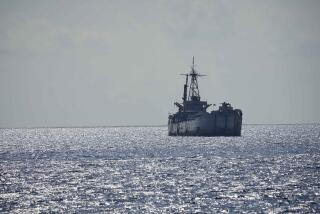Somali pirates recapture American captain after escape attempt
- Share via
WASHINGTON AND NAIROBI, KENYA — Adrift with his captors in sight of U.S. warships, the American sea captain being held for ransom by Somali pirates briefly escaped their lifeboat by jumping overboard, a U.S. official said Friday, but was recaptured and brought back.
The U.S. military said Richard Phillips, who was taken by the pirates from the U.S.-flagged Maersk Alabama on Wednesday, appeared unharmed after the escape attempt. The military, which has been maintaining real-time video surveillance via a drone aircraft, observed him moving around on the lifeboat after he was recaptured.
But another hostage drama off the coast of Somalia turned bloody. French naval forces attacked pirates holding a yacht 40 miles offshore. One hostage and two pirates were killed, the French government said. The yacht, which was carrying a French couple, their small child and two friends, was seized this month.
It was one of more than a dozen vessels being held by pirates operating out of ports in the chaotic Horn of Africa country, which has not had an effective government since 1991. The pirates typically move the hijacked vessels close to shore and then open negotiations for a ransom.
During 2008, the pirates are believed to have collected more than $50 million. In response to a spate of hijackings, including that of a Ukrainian ship carrying 33 battle tanks and a Saudi tanker with $100 million of crude oil, warships from North Atlantic Treaty Organization countries, including the U.S., and other navies have been patrolling the area since last year.
Sources in Somalia said they had heard that the pirates holding Phillips had made a ransom demand Friday, and news reports said a Norwegian-owned tanker was freed after a ransom was paid.
But other Somali maritime experts predicted that, facing the firepower of two U.S. warships, Phillips’ captors were probably looking for a way out.
Pentagon officials said they had heard, but could not confirm, that Phillips was pulled back into the lifeboat by one of the pirates who jumped into the water after him.
The escape drama marked the third day of captivity for Phillips, 55, who is drifting in a 24-foot lifeboat in the Indian Ocean about 250 miles off the Somali coast. The rest of his 20-person, American crew managed to retake the 17,000-ton Maersk Alabama from pirates who boarded it and attempted to seize control. They are now cruising toward their original destination, the Kenyan port of Mombasa, with a cargo of food aid for African countries.
With the Maersk Alabama gone from the scene, two large U.S. naval vessels, the destroyer Bainbridge and the frigate Halyburton, were keeping watch.
One report from Somalia suggested that the pirates were demanding money and free passage to shore in exchange for Phillips.
“They made a ransom demand earlier this morning, but I’m not sure if the Americans are meeting their demands,” said Mohammed Jama, a trader in the port city of Eyl, who sells fuel to pirates. His account could not be verified.
Though the pirates have radio contact with the Bainbridge, it was unclear whether they had a satellite phone. U.S. officials and representatives of the shipowner, Norfolk, Va.-based Maersk Line Ltd., have declined to comment on negotiations.
Witnesses said pirates on several ships were rushing to the scene in an apparent bid to assist their trapped colleagues. One of the ships, according to wire reports, was a hijacked German freighter with a crew of more than 20 that later headed back toward the coast.
It was unclear whether any such vessels would be able to penetrate the Navy security perimeter. U.S. officials vowed to keep other vessels away from the lifeboat and said they would block the cornered pirates from moving to another vessel or resupplying. The U.S. negotiating position will grow stronger, officials predicted, as the pirates run low on supplies.
Bryan Whitman, a Pentagon spokesman, declined to comment on why the Navy did not have smaller boats in the water, which might have been better positioned to assist the captain during the escape attempt. One family friend of Phillips’ suggested in a television interview Friday that the Navy had not been prepared to respond to the captain’s move.
Whitman called such characterizations an “oversimplification.”
“People can second-guess the activities task force out there, but this is a vast body of water,” Whitman said. “To operate in those waters and to be able to maneuver around, you need vessels that can move distances and have staying power.”
One Somali maritime expert said the pirates were probably growing tired and might be ready to give up.
“They’re probably saying to themselves that they’ve made a very big mistake by taking this American and now they are wondering how they will survive,” said Abdi Wali Alitaar, a businessman who runs a maritime security firm in the port city of Bosasso.
At the same time, Alitaar faulted the U.S. for not seeking more assistance and support from inside Somalia, including clan leaders, government officials and private consultants such as himself. He said his firm has a track record of rescuing hijacked ships and capturing pirates.
Longer-term, he said, sending foreign warships to patrol waters and combat piracy “will absolutely fail.”
“How long are the Americans really going to stay?” he said.
“A year or two? These pirates will just go on vacation and come back after the Americans leave.”
--
edmund.sanders@latimes.com
A special correspondent in Mogadishu, Somalia, contributed to this report.
More to Read
Sign up for Essential California
The most important California stories and recommendations in your inbox every morning.
You may occasionally receive promotional content from the Los Angeles Times.










